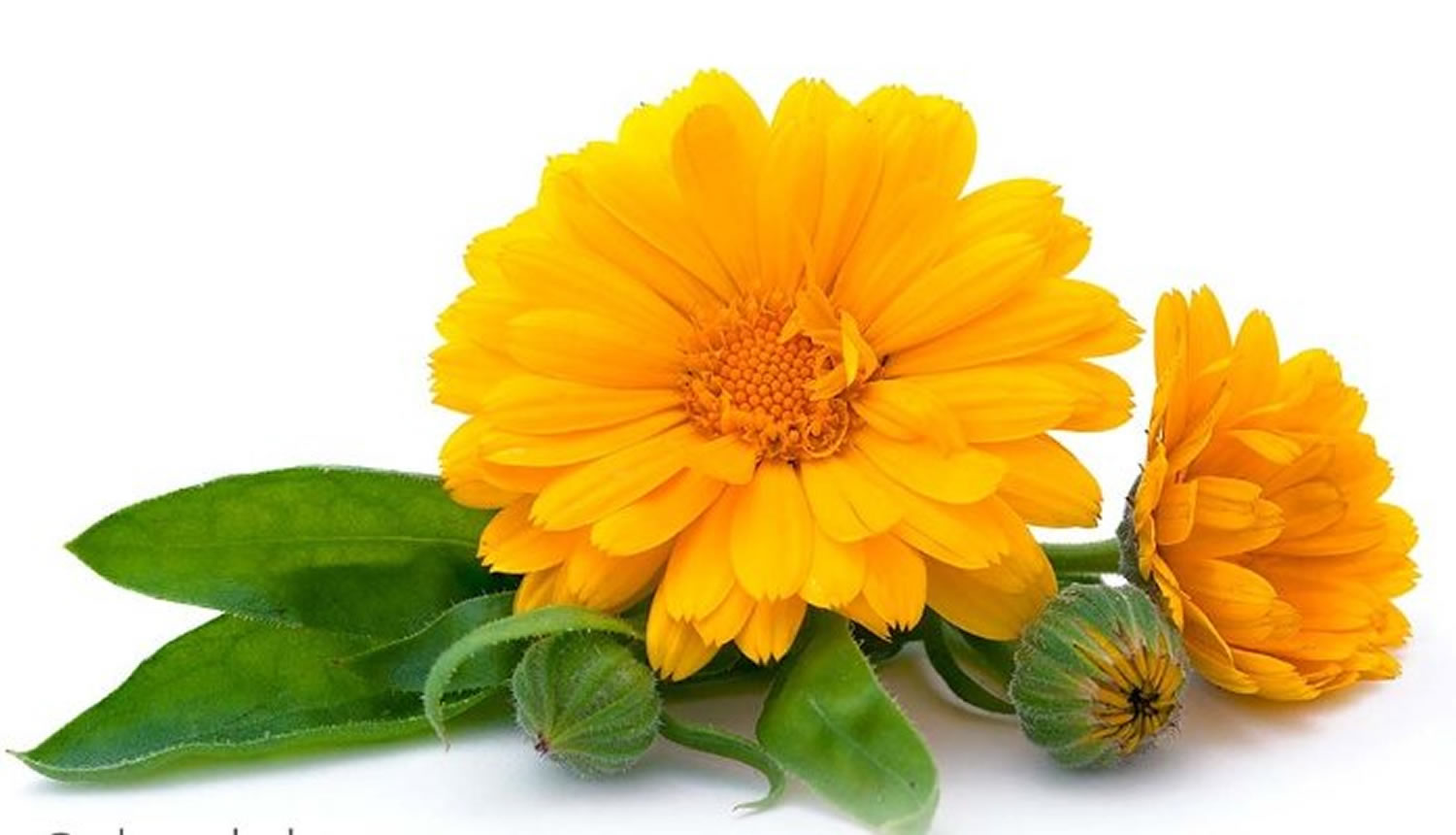What is calendula ?
The genus Calendula (Asteraceae) includes approximately 25 herbaceous annual or perennial species, most common being Calendula officinalis Linn., Calendula arvensis Linn., Calendula suffruticosa Vahl., Calendula stellata Cav., Calendula alata Rech., Calendula tripterocarpa Rupr 1. The genus is native to the Mediterranean countries 2. Calendula are often known as marigolds 3.
Figure 1. Calendula plant
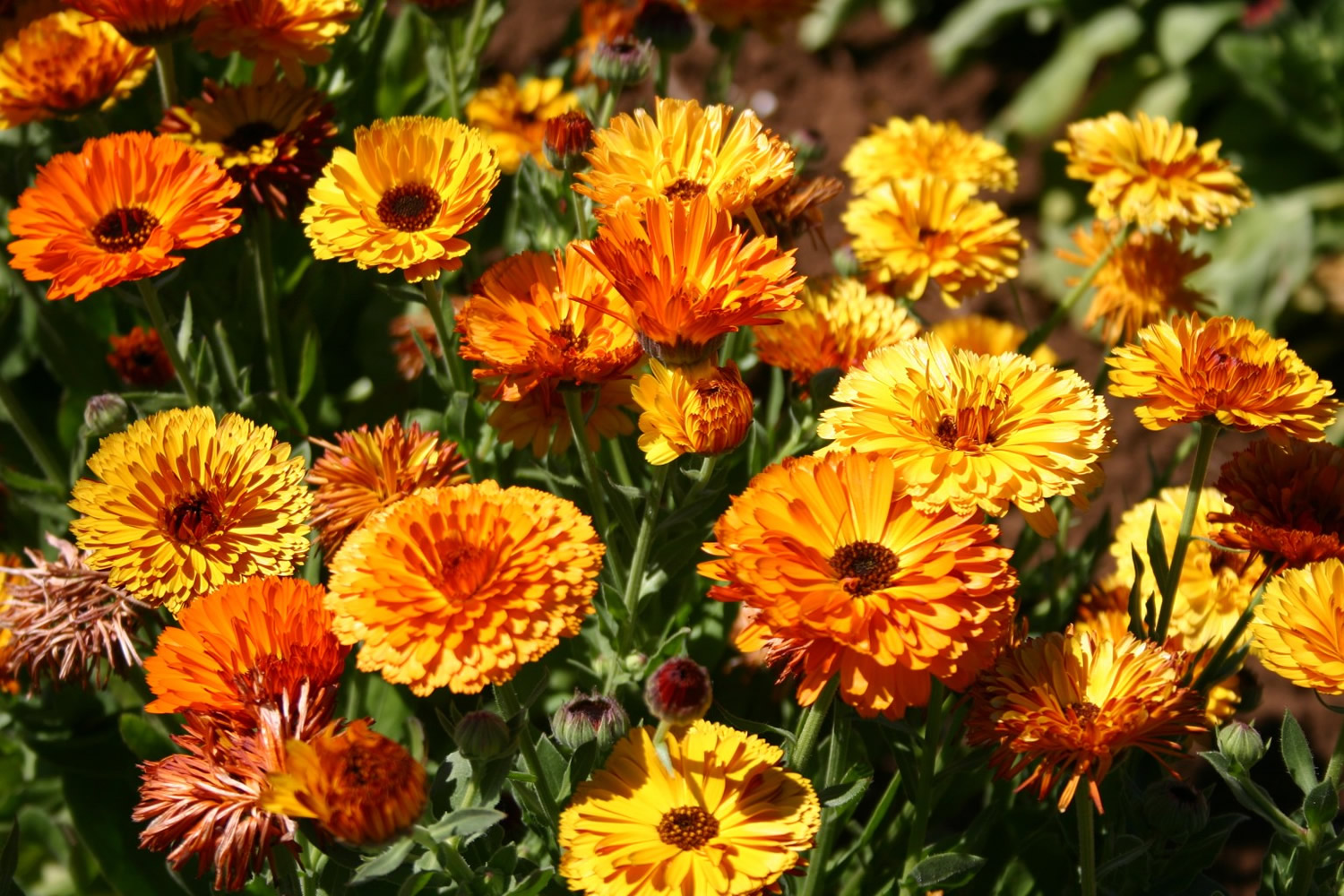
Figure 2. Calendula seeds
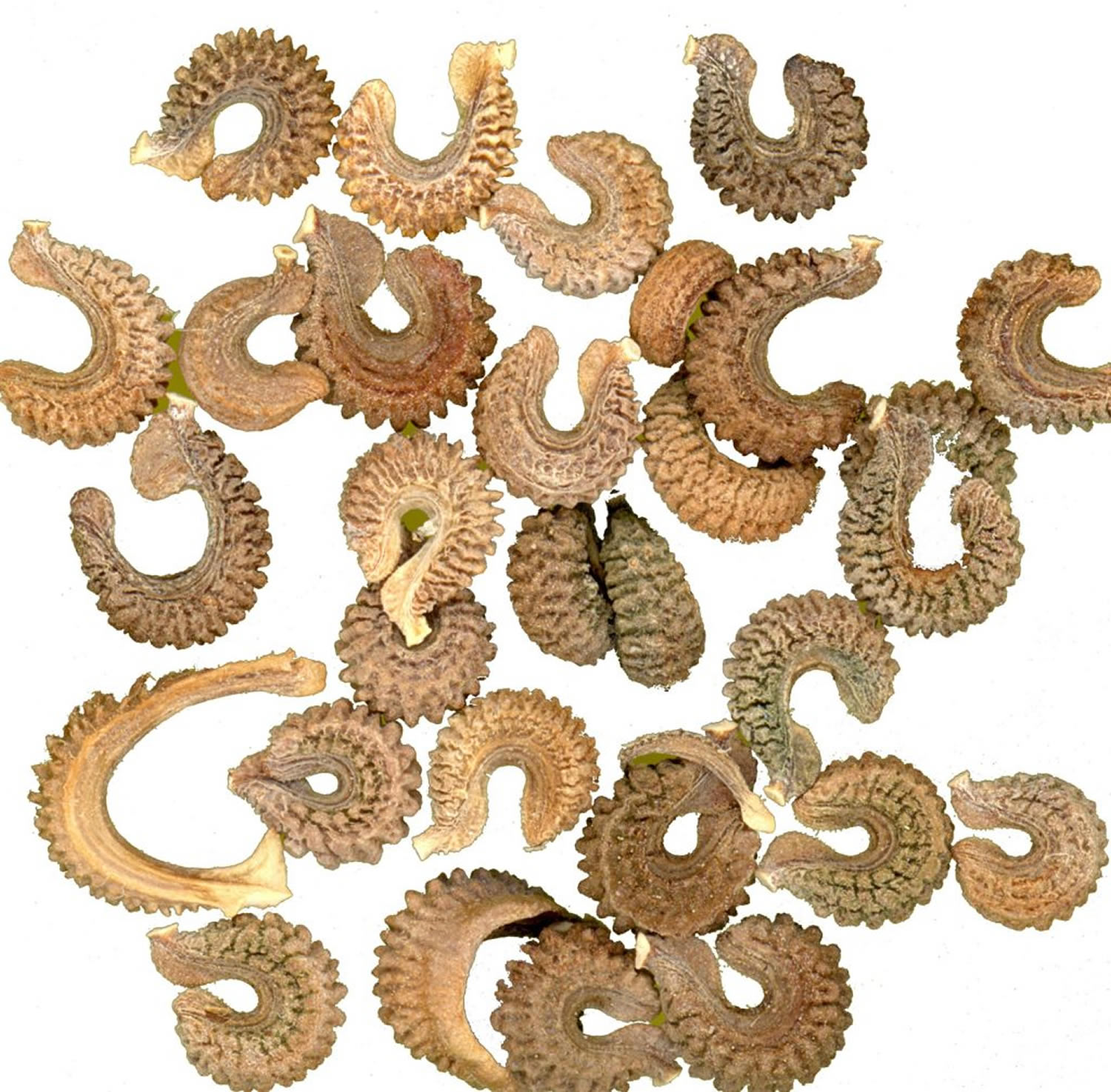
Morphology and microscopy of Calendula
Calendula arvensis Linn. is an annual herb, not generally exceeding 15 cm in height. Leaves lance-shaped; stem slender, hairy; inflorescence single flower head up to 4 cm wide with bright yellow to yellow-orange ray florets around a center of yellow disc florets 4, 5.
Calendula officinalis Linn. [Figure 3] is an annual or biennial plant attaining height of 30-60 cm. Leaves lower spatulate, 10-20 cm long and 1-4 cm wide; higher oblong and mucronate, 4-7 cm long; stem angular, hairy and solid; flower heads bright yellow to orange; marginal flowers in cultivated plants multi-seriate, corolla oblong spatulate, 15-25 mm long and 3 mm wide; corolla of disc flowers rounded, at the top tridentate, 1.5-2.5 cm long and 4-7 mm in diameter with 5 mm long tubular florets 6, 7.
Figure 3. Calendula officinalis Linn (Pot marigold)
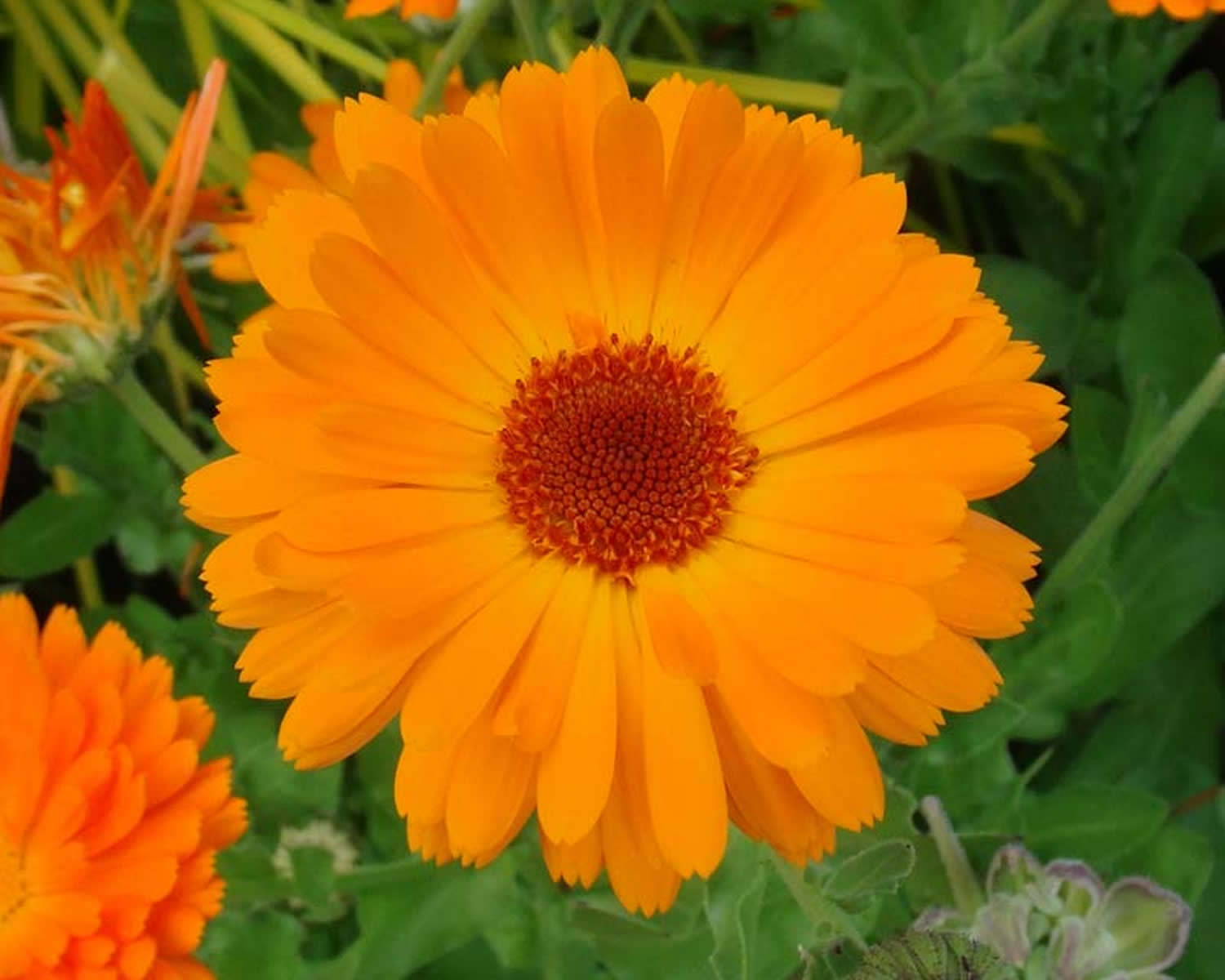
The powdered Calendula officinalis is yellowish brown with a characteristic, aromatic odor and a slightly bitter taste; comprises fragments of the corolla, anomocytic stomata in the apical region of outer epidermis, covering and glandular trichomes, elongated sclerenchymatous cells, pollen grains, fragments of the walls of the ovaries containing brown pigment, fragments of stigma, fragments of the fibrous layer of the others 9, 10.
Calendula stellata Cav., is a small, attractive annual growing to a height of 30 cm or more. Leaves oval or oblong, somewhat pointed, wavy-toothed 11; stems scabrous; achenes outer five with membranous toothed margins, the five inner ones “boat-shaped” and smooth on the back, the rest angular and muricated on the back 12.
Calendula suffruticosa Vahl., is a perennial plant reaching a height between 20 cm and 40 cm. Leaves lance-shaped, slightly toothed, covered with short sticky hairs; stem young one first erected, later begin to hang and spread to the soil; flowers bright yellow, each measuring about 2.5 cm in diameter 13.
Traditional uses of Calendula
Calendula alata Rech.f., aerial parts are used for the treatment of kidney stones and gall stones 14.
Calendula arvensis Linn. (Field marigold) has been used as disinfectant, antispasmodic and diuretic 15. In Italian folk medicine, the plant is used as anti-inflammatory, anticancer and antipyretic agent 16. In Spain, the leaves are considered sweat inducer. Traditionally, it is used as an emmenagogue (stimulates or increases menstrual flow), diaphoretic (inducing perspiration) and sedative 17. It is known to have wound healing properties and crushed leaves are topically applied on wounds 18. The concentrated liquor resulting from heating or boiling of the Calendula flower heads has been used for treating burns 19.
Figure 4. Calendula flower
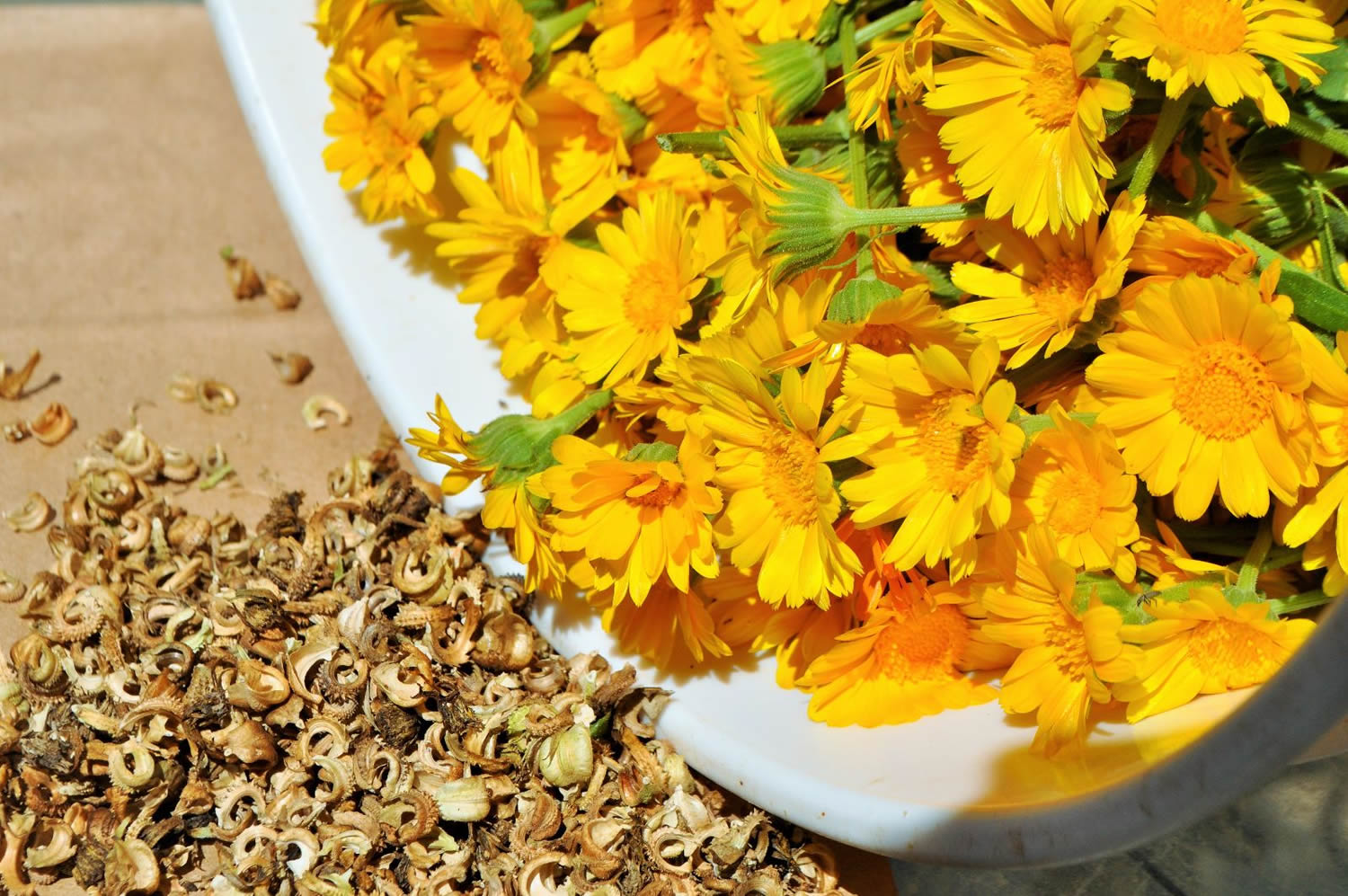
Calendula officinalis Linn. (Pot marigold) has been traditionally used in the treatment of inflammations of internal organs, gastrointestinal ulcers and dysmenorrhea (painful menstruation) and as a diuretic (increased passing of urine) and diaphoretic (inducing perspiration) in convulsions. It is also used for inflammations of the oral and pharyngeal mucosa, wounds and burns 20. Calendula is a cleansing and detoxifying herb and the infusion treat chronic infections 21. The dried flower heads have been used for their antipyretic, anti-tumor and cicatrizing effects 22. Topical application of infusion of flowers is used as antifungal and antiseptic in wounds, marks, freckles, sprain and conjunctivitis 23. Calendula tea is used as eyewashes, gargles, diaper rashes and other inflammatory conditions of the skin and mucous membranes 24. Mother tincture of Calendula officinalis is used in homoeopathy for the treatment of mental tension and insomnia 25.
Medicinal properties of Calendula officinalis have been mentioned in Ayurvedic and Unani system of medicine indicating that leaves and flowers are antipyretic, anti-inflammatory, antiepileptic and antimicrobial 26. In traditional and homoeopathic medicine, C. officinalis has been used for poor eyesight, menstrual irregularities, varicose veins, hemorrhoids and duodenal ulcers 27. In the middle ages, Calendula flowers were used for liver obstructions, snake bites and to strengthen the heart. It was used in the 18th century as a remedy for headache, jaundice and red eyes. The plant was employed in the civil war to treat wounds and as a remedy for measles, smallpox and jaundice 28.
A concentrated liquor resulting from heating or boiling and infusion of Calendula persica C.A. Mey aerial parts are employed for the treatment of kidney stones 14.
Calendula active constituents
Four species of Calendula have been investigated phytochemically. Table 1 summarizes the phytoconstituents of different species of Calendula. Figure 5 represents chemical structures of some phytoconstituents reported from the genus Calendula.
Table 1. Phytoconstituents of different species of Calendula
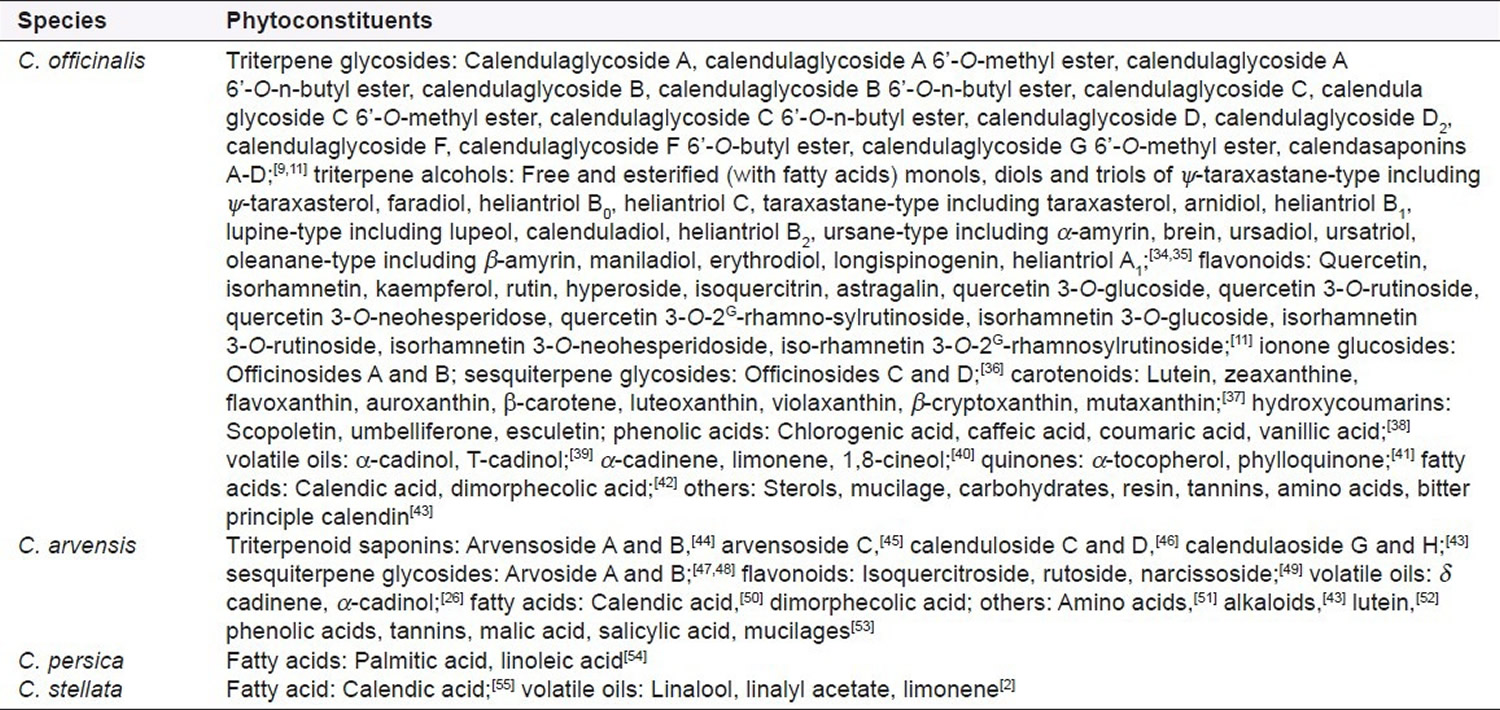
Figure 5. Chemical structures of some phytoconstituents reported from the genus Calendula
[Source 8]The available literature reveals that amongst 12-20 species of Calendula, only three species, i.e., Calendula officinalis, Calendula arvensis and Calendula suffruticosa have been evaluated for their pharmacological activities.
Tincture of Calendula arvensis was active against Staphylococcus aureus at concentrations of 10 mg/ml or 25 mg/ml 29. Sesquiterpene glycosides from Calendula arvensis were able to inhibit vesicular stomatitis virus infection 30. A saponin containing fraction from the aerial parts of Calendula arvensis had hemolytic activity in vitro and anti-inflammatory activity against carrageenan induced paw edema in rats 31. Saponins showed antimutagenic activity against benzo (a) pyrene 1 μg and mutagenic urine concentrate from a smoker 5 μL with a dose-response relationship 32.
Preparations of Calendula officinalis are mainly applied in the form of infusions, tinctures and ointments as a wound healing remedy for inflammations of the skin, mucous membranes, for poorly healing wounds, bruises, boils and rashes, e.g., pharyngitis and leg ulcers 6. In the mixed lymphocyte reaction, 70% ethanol extract showed stimulatory effects at 0.1-10 μg/ml, followed by inhibition at higher concentrations 33. Phagocytosis of human granulocytes was stimulated by polysaccharides isolated from aqueous extract of Calendula flowers 34. Extracts of Calendula flowers of differing polarities exhibited anti-oxidative effects on liposomal lipid peroxidation induced by Fe2 + and ascorbic acid 35, 36. Isorhamnetin 3-glycosides from Calendula flowers inhibited lipoxygenase from rat lung cytosol at a concentration of 1.5 × 10-5 M 37. In a test system based on porcine buccal membranes, strong concentration dependent adhesive processes were observed with a low viscosity polysaccharide enriched extract (98% carbohydrates) of Calendula flowers. These findings suggested that the polysaccharides may contribute to therapeutic effects in the treatment of irritated mucosa 38. A triterpene enriched fraction given orally to mice inoculated with Ehrlich mouse carcinoma prevented the development of ascites and increased survival time compared to control 39. Triterpenes such as faradiol and taraxasterol inhibit experimental tumor promotion and are therefore considered as inhibitors of tumor growth 40. A saponin rich fraction administered orally at 50 mg/kg body weight to hyperlipemic rats reduced the serum lipid level 41, 42. The aqueous alcohol extract of C. officinalis showed central nervous system inhibitory effect with marked overall sedative activity as well as hypotensive effect 43. The alcohol extract of flowers of C. officinalis possesses anti-HIV properties 44. A cream containing calendula extract has been reported to be effective in dextran and burn edemas as well as in acute lymphedema in rats. Activity against lymphedema was primarily attributed to enhancement of macrophage proteolytic activity 45. The essential oil of the flowers inhibited the growth in vitro of Bacillus subtilis, Escherichia coli, S. aureus, Pseudomonas aeruginosa and Candida albicans 46. Acetone, ethanol or water extracts inhibited the growth in vitro of the fungus Neurospora crass 47. A flavonoid fraction isolated from the flowers inhibited the in vitro growth of S. aureus, Sarcina lutea, E. coli, Klebsiella pneumonia and Candida monosa 48. The 50% ethanol extract of the plant showed spermicidal activity in rats at 2% concentration 49.
Calendula suffruticosa inhibited pathogenic micro-organisms, especially Pseudomonas syringae, Pseudomonas fluorescens, Xanthomonas campestris, Agrobacterium tumefaciens 50.
Calendula benefits
Today, calendula is not usually taken by mouth. The exception is when it is used in extremely small amounts in homeopathic preparations. Calendula is usually applied topically, to the skin 51. Among the various species of the genus Calendula, C. officinalis (Pot marigold) is the only one, which is extensively used clinically throughout the world. The plant is listed in German Commission E, European Scientific Co-operative on Phytotherapy, British Herbal Pharmacopoeia, World Health Organization monographs for wound healing and anti-inflammatory actions 52. Calendula officinalis preparations are used in various complementary and alternative medicine systems mainly for burns, cuts, rashes, dermatitis and varicosis 53. It is also included as part of treatment for dry skin, bee stings and foot ulcers 54. The essential oil of the plant is used for soothing central nervous system and as a wound healer 55.
Calendula officinalis (Pot marigold) preparations currently in use include carophyllenic ointment (containing carotenoids extracted from the flowers) and pot marigold tincture. It is one of the constituents of proprietary homoeopathic medicine Traumeel®, used for treating the symptoms associated with acute musculoskeletal injuries including pain and swelling 56. Otikon otic solution and naturopathic herbal extract ear drops solution, ear drop formulations of naturopathic origin containing Calendula flowers, have been reported to be effective for the management of otalgia associated with acute otitis media in children 57, 58.
Calendula Clinical studies
Professional homeopaths often recommend using ointments with calendula to heal first-degree burns and sunburns. In a randomized, open controlled study, the effects of three ointments were compared after topical treatment of patients with 2nd or 3rd degree burns for 17 days: Calendula flower ointment (prepared by digestion in vaseline) (n = 53) or vaseline only (n = 50) or a proteolytic ointment (n = 53). The success rates were considered to be 37/53 for Calendula flower ointment, 27/50 for vaseline and 35/53 for the proteolytic ointment 59. In an open uncontrolled pilot study, 30 patients with burns or scalds were treated 3 times/day for up to 14 days with a hydrogel containing 10% of a hydro-ethanol extract. The symptoms reddening, swelling, blistering, pain, soreness and heat sensitivity were scored before, during and at the end of treatment. Total score and individual scores for each symptom improved 60. Due to the poor quality of those 2 studies 59, 60, it is fair to say using Calendula flower ointment for 2nd and 3rd degree skin burns is not ideal when you have much better option like honey. For honey there is high quality evidence that showed honey heals partial thickness burns around 4 to 5 days more quickly than conventional dressings 61. And there is moderate quality evidence that showed honey is more effective than antiseptic followed by gauze for healing wounds infected after surgical operations 61. There is good strong clinical evidence supporting the use of honey to heal partial thickness burns more quickly than conventional treatment (which included polyurethane film, paraffin gauze, soframycin-impregnated gauze, sterile linen and leaving the burns exposed) and infected post-operative wounds more quickly than antiseptics and gauze 61. These finding on the benefits of honey in healing burn wounds more quickly and are more likely to heal compared with those treated with topical antibiotics, were further supported by the most recent clinical data review published 12 July 2017 62.
In women with surgical wounds, local application of a mixture containing 70% oily extract of Hypericum perforatum and 30% oily extract of Calendula arvensis improved the rate of healing, compared with controls 63.
Phase III randomized single blinded trial of Calendula officinalis compared with trolamine for the prevention of acute dermatitis during irradiation for breast cancer was conducted. Patients who had been operated on for breast cancer and who were to receive post-operative radiation therapy were randomly allocated to application of either Calendula ointment containing 20% of fresh Calendula aerial parts in petroleum jelly (126 patients) or trolamine (128 patients) on the irradiated fields after each session. The primary end point was the occurrence of acute dermatitis of grade 2 or higher. Secondary end points were the occurrence of pain, the quantity of the topical agent used and the patient satisfaction. The occurrence of acute dermatitis of grade 2 or higher was significantly lower (41% vs. 63%) with the use of Calendula than with trolamine. Moreover, patients receiving Calendula had less frequent interruption of radiotherapy and significantly reduced radiation-induced pain 64.
Clinical examination of an ointment with Calendula officinalis extract was carried out in 34 patients with venous leg ulcer. A total of 21 patients with 33 venous ulcers were treated with ointment, applied twice a day for 3 weeks. Control group that consisted of 13 patients with 22 venous ulcers were treated with saline solution dressings, applied to ulcers for 3 weeks. In the experimental group, the total surface of all the ulcers at the beginning of the therapy was 67,544 mm2. After the 3rd week, the total surface of all the ulcers was 39,373 mm2 (a decrease of 41.71%). In seven patients, complete epithelialization was achieved. In the control group, the total surface of all ulcers at the beginning of the therapy was 69,722 mm2. After the 3rd week, the total surface of all ulcers was 58,743 mm2 (a decrease of 14.52%). In four patients, complete epithelialization was achieved. There was a statistically significant acceleration of wound healing in the experimental group, suggesting the positive effects of the ointment with marigold extract on venous ulcer epithelialization 65.
Side Effects and Safety of Calendula
No carcinogenicity or reproductive and developmental toxicity data were available on Calendula officinalis or Calendula officinalis extract. Additional data are needed include current concentration of use data; function in cosmetics; ultraviolet (UV) absorption data; if absorption occurs in the UVA or UVB range, photosensitization data are needed; gross pathology and histopathology in skin and other major organ systems associated with repeated dermal exposures; dermal reproductive/developmental toxicity data; inhalation toxicity data, especially addressing the concentration, amount delivered, and particle size; and genotoxicity testing in a mammalian system. Until these data are available, it is concluded that the available data are insufficient to support the safety of these ingredients in cosmetic formulations.
Although rare, skin contact with Calendula preparations may result in an allergic reaction to the herb. Sensitization to Calendula and allergic contact reactions have been reported 66, 67. There have also been incidents of anaphylactic shock after gargling with an infusion of Calendula 68.
Summary
About 12-20 species of the genus Calendula have been reported in various floras. Among these, most of the ethnopharmacological reports are available on Calendula officinalis and Calendula arvensis. Further, only four species of Calendula have been partially investigated for their phytoconstituents. A close scrutiny of literature on Calendula reveals that three species have been investigated pharmacologically. Pharmacological studies reveal that:
- Calendula officinalis exhibits antibacterial, antiviral, anti-inflammatory, anti-tumor and antioxidant properties;
- Calendula arvensis possesses antibacterial, anti-inflammatory, antimutagenic and hemolytic activities; and
- Calendula suffruticosa exhibits antimicrobial activity.
Calendula officinalis has been included in number of herbal formulations, which are in clinical use for the treatment of various ailments like central nervous system disorders.
Professional homeopaths often recommend using ointments with calendula to heal first-degree burns and sunburns. In addition, Calendula tinctures, ointments, and washes are often applied to the skin to help burns, bruises, and cuts heal faster, and to fight the minor infections they cause. Calendula cream is also used to treat hemorrhoids. However there are no scientific studies looking at whether calendula works in humans, but using it on your skin is considered safe. Although rare, skin contact with Calendula preparations may result in an allergic reaction to the herb. Sensitization to Calendula and allergic contact reactions have been reported 66, 67.
Calendula officinalis extract is reported to be used in almost 200 cosmetic formulations, over a wide range of product categories 69. Due to the lack of human clinical studies on the effect of Calendula officinalis as cosmetic products, human clinical data are needed to ascertain the current concentration of use data; function of Calendula officinalis in cosmetics; ultraviolet (UV) absorption data; if absorption occurs in the UVA or UVB range, photosensitization data; gross pathology and histopathology in skin and other major organ systems associated with repeated dermal exposures to Calendula officinalis extract; dermal reproductive/developmental toxicity data; inhalation toxicity data, especially addressing the concentration, amount delivered, and particle size; and genotoxicity testing in a mammalian system. Until these data are available, it can safely be concluded that the available data are insufficient to support the safety of these Calendula ingredients in cosmetic formulations.
Lastly, there have also been report of incidents of anaphylactic shock after gargling with an infusion of Calendula 68.
- Baciu AD, Mihalte L, Sestras AF, Sestras RE. Variability of decorative traits, response to the Aphis fabae attack and RAPD diversity in different genotypes of Calendula. Not Bot Hort Agrobot Cluj. 2010;38:265–70.[↩]
- Naguib NY, Khalil MY, El Sherbeny SE. A comparative study on the productivity and chemical constituents of various sources and species of Calendula plants as affected by two foliar fertilizers. J Appl Sci Res. 2005;1:176–89.[↩]
- Stace, C. A. (2010). New Flora of the British Isles (Third ed.). Cambridge, U.K.: Cambridge University Press. ISBN 9780521707725.[↩]
- Ruiz de Clavijo E. The reproductive strategies of the heterocarpic annual Calendula arvensis (Asteraceae) Acta Oncol. 2005;28:119–26.[↩]
- Paolini J, Barboni T, Desjobert JM, Djabou N, Muselli A, Costa J. Chemical composition, intraspecies variation and seasonal variation in essential oils of Calendula arvensis L. Biochem Syst Ecol. 2010;38:865–74.[↩]
- Bisset NG, Wichtl M. 2nd ed. Stuttgart, Germany: Medpharm Scientific Publishers; 2001. Herbal Drugs and Phytopharmaceuticals; pp. 118–20.[↩][↩]
- Mills SY. Harmondsworth, Middlesex: Penguin Books Ltd; 1992. The Essential Book of Herbal Medicine.[↩]
- Arora D, Rani A, Sharma A. A review on phytochemistry and ethnopharmacological aspects of genus Calendula. Pharmacognosy Reviews. 2013;7(14):179-187. doi:10.4103/0973-7847.120520. https://www.ncbi.nlm.nih.gov/pmc/articles/PMC3841996/[↩][↩][↩]
- Jackson BP, Snowdon DW. New Delhi: CBS Publishers and Distributors (P) Ltd; 1992. Atlas of Microscopy of Medicinal Plants: Culinary Herbs and Spices; p. 154.[↩]
- Vol. 2. Geneva: World Health Organization; 2002. WHO. WHO Monographs on Selected Medicinal Plants; pp. 35–44.[↩]
- Booth CO. Vol. 2. Delhi: Daya Books; 1999. Encyclopaedia of Garden Plants; pp. 202–3.[↩]
- Loudon J. London: W. Smith; 1811. The Ladies’ Flower-Garden of Ornamental Annuals; p. 206.[↩]
- Tutin TG. Vol. 4. Cambridge, United Kingdom: University Press; 1976. Flora Europaea: Plantaginaceae to Compositae (and Rubiaceae) pp. 206–7.[↩]
- Ghorbani A. Studies on pharmaceutical ethnobotany in the region of Turkmen Sahra, north of Iran (Part 1): General results. J Ethnopharmacol. 2005;102:58–6. https://www.ncbi.nlm.nih.gov/pubmed/16024194[↩][↩]
- Tiwari S. Plants: A rich source of herbal medicine. J Nat Prod. 2008;1:27–33.[↩]
- Anonymous. Vol. 1. New Delhi: National Institute of Sciences Communication and Information Resources, Council of Scientific and Industrial Research; 2000. pp. 185–6.[↩]
- Dall’Acqua S, Cervellati R, Loi MC, Innocenti G. Evaluation of in vitro antioxidant properties of some traditional Sardinian medicinal plants: Investigation of the high antioxidant capacity of Rubus ulmifolius. Food Chem. 2008;106:745–9.[↩]
- Abbasi AM, Khan MA, Ahmad M, Zafar M, Jahan S, Sultana S. Ethnopharmacological application of medicinal plants to cure skin diseases and in folk cosmetics among the tribal communities of North-West Frontier Province, Pakistan. J Ethnopharmacol. 2010;128:322–35. https://www.ncbi.nlm.nih.gov/pubmed/20138210[↩]
- Passalacqua NG, Guarrera PM, De Fine G. Contribution to the knowledge of the folk plant medicine in Calabria region (Southern Italy) Fitoterapia. 2007;78:52–68. https://www.ncbi.nlm.nih.gov/pubmed/17084993[↩]
- Yoshikawa M, Murakami T, Kishi A, Kageura T, Matsuda H. Medicinal flowers. III. Marigold. (1): Hypoglycemic, gastric emptying inhibitory, and gastroprotective principles and new oleanane-type triterpene oligoglycosides, calendasaponins A, B, C, and D, from Egyptian Calendula officinalis. Chem Pharm Bull (Tokyo) 2001;49:863–70. https://www.ncbi.nlm.nih.gov/pubmed/11456093[↩]
- Blumenthal M, Goldberg A, Brinckmann J. Austin, TX, Boston: American Botanical Council, Integrative Medicine Communications; 2001. Herbal Medicine: Expanded Commission E Monographs; pp. 376–8.[↩]
- Ukiya M, Akihisa T, Yasukawa K, Tokuda H, Suzuki T, Kimura Y. Anti-inflammatory, anti-tumor-promoting, and cytotoxic activities of constituents of marigold (Calendula officinalis) flowers. J Nat Prod. 2006;69:1692–6. https://www.ncbi.nlm.nih.gov/pubmed/17190444[↩]
- Rehecho S, Uriarte-Pueyo I, Calvo J, Vivas LA, Calvo MI. Ethnopharmacological survey of medicinal plants in Nor-Yauyos, a part of the Landscape Reserve Nor-Yauyos-Cochas, Peru. J Ethnopharmacol. 2011;133:75–8. https://www.ncbi.nlm.nih.gov/pubmed/20837126[↩]
- Safdar W, Majeed H, Naveed I, Kayani WK, Ahmed H, Hussain S, et al. Pharmacognostical study of the medicinal plant Calendula officinalis L. (family Compositae) Int J Cell Mol Biol. 2010;1:108–16.[↩]
- Boericke W. New Delhi: Jain Publishers Pvt. Ltd; 1998. Pocket Manual of Homoeopathic Material Medica. B; pp. 156–83.[↩]
- Kasiram K, Sakharkar P, Patil A. Antifungal activity of Calendula officinalis. Indian J Pharm Sci. 2000;62:464–6.[↩]
- Cetkovic GS, Djilas SM, Canadanovic-Brunet JM, Tumbas VT. Antioxidant properties of marigold extracts. Food Res Int. 2004;37:643–50.[↩]
- Page L. Carmel Valley, California, United States of America: Healthy Healing Publications; 1998. Detoxification: All You Need to Know to Recharge, Renew and Rejuvenate Your Body, Mind and Spirit; pp. 191–2.[↩]
- Dumenil G, Chemli R, Balansard C, Guiraud H, Lallemand M. Evaluation of antibacterial properties of marigold flowers (Calendula officinalis L.) and mother homeopathic tinctures of C. officinalis L. and C. arvensis L. (author’s transl) Ann Pharm Fr. 1980;38:493–9. https://www.ncbi.nlm.nih.gov/pubmed/7283346[↩]
- De Tommasi N, Pizza C, Conti C, Orsi N, Stein ML. Structure and in vitro antiviral activity of sesquiterpene glycosides from Calendula arvensis. J Nat Prod. 1990;53:830–5. https://www.ncbi.nlm.nih.gov/pubmed/1965654[↩]
- Chemli R, Toumi A, Oueslati S, Zouaghi H, Boukef K, Balansard G. Calendula arvensis L. Impact of saponins on toxicity, hemolytic effect, and anti-inflammatory activity. J Pharm Belg. 1990;45:12–6. https://www.ncbi.nlm.nih.gov/pubmed/2332827[↩]
- Elias R, De Méo M, Vidal-Ollivier E, Laget M, Balansard G, Dumenil G. Antimutagenic activity of some saponins isolated from Calendula officinalis L., C. arvensis L. and Hedera helix L. Mutagenesis. 1990;5:327–31. https://www.ncbi.nlm.nih.gov/pubmed/2204784[↩]
- Amirghofran Z, Azadbakht M, Karimi MH. Evaluation of the immunomodulatory effects of five herbal plants. J Ethnopharmacol. 2000;72:167–72. https://www.ncbi.nlm.nih.gov/pubmed/10967468[↩]
- Varljen J, Liptak A, Wagner H. Structural analysis of a rhamno-arabinogalactan and arabinogalactans with immuno-stimulating activity from Calendula officinalis. Phytochemistry. 1989;28:2379–83.[↩]
- Popovic M, Kourinovic B, Mimica-Dukic N, Vojinovic-Miloradav M, Cupic V. Combined effects of plant extracts and xenobiotics on liposomal lipid peroxidation. Part I. Marigold extract-ciprofloxacin/pyralene. Oxid Commun. 1999;22:487–94.[↩]
- Popovic M, Kourinovic B, Mimica-Dukic N, Vojinovic-Miloradav M, Djordjevic A. Combined effects of plant extracts and xenobiotics on liposomal lipid peroxidation. Part II. Marigold extract-CCl4/fullerenol. Oxid Commun. 2000;23:178–86.[↩]
- Bezákova L, Masterová I, Paulíková I, Psenák M. Inhibitory activity of isorhamnetin glycosides from Calendula officinalis L. on the activity of lipoxygenase. Pharmazie. 1996;51:126–7. https://www.ncbi.nlm.nih.gov/pubmed/8720810[↩]
- Schmidgall J, Schnetz E, Hensel A. Evidence for bioadhesive effects of polysaccharides and polysaccharide-containing herbs in an ex vivo bioadhesion assay on buccal membranes. Planta Med. 2000;66:48–53. https://www.ncbi.nlm.nih.gov/pubmed/10705734[↩]
- Boucaud-Maitre Y, Algernon O, Raynaud J. Cytotoxic and antitumoral activity of Calendula officinalis extracts. Pharmazie. 1988;43:220–1. https://www.ncbi.nlm.nih.gov/pubmed/3380875[↩]
- Yasukawa K, Akihisa T, Oinuma H, Kaminaga T, Kanno H, Kasahara Y, et al. Inhibitory effect of taraxastane-type triterpenes on tumor promotion by 12-O-tetradecanoylphorbol-13-acetate in two-stage carcinogenesis in mouse skin. Oncology. 1996;53:341–4. https://www.ncbi.nlm.nih.gov/pubmed/8692541[↩]
- Samochowiec L. Pharmakologische untersuchungen der saponosiden von Aralia mandshurica rupr. et Maxim. und Calendula officinalis L. Herba Pol. 1983;29:151–5.[↩]
- Wojcicki J, Samochowiec L. Comparative evaluation of the effect of Aralia mandshurica Rupr. et Maxim and Calendula officinalis L. saponosides on lipid level in blood serum and liver homogenates. Herba Pol. 1980;26:233–7.[↩]
- Bojadjiev C. On the sedative and hypotensive effect of preparations from the plant Calendula officinalis. Nauchni Tr Vissh Med Inst Sofiia. 1964;43:15–20. https://www.ncbi.nlm.nih.gov/pubmed/14221993[↩]
- Kalvatchev Z, Walder R, Garzaro D. Anti-HIV activity of extracts from Calendula officinalis flowers. Biomed Pharmacother. 1997;51:176–80. https://www.ncbi.nlm.nih.gov/pubmed/9207986[↩]
- Casley-Smith JR, Casley-Smith JR. The effect of “Unguentum lymphaticum” on acute experimental lymphedema and other high-protein edemas. Lymphology. 1983;16:150–6. https://www.ncbi.nlm.nih.gov/pubmed/6195489[↩]
- Janssen AM, Chin NL, Scheffer JJ, Baerheim Svendsen A. Screening for antimicrobial activity of some essential oils by the agar overlay technique. Pharm Weekbl Sci. 1986;8:289–92. https://www.ncbi.nlm.nih.gov/pubmed/3808913[↩]
- Kubas J. Investigations on known or potential antitumoural plants by means of microbiological tests. Part III. Activity of some cultivated plant species in Neurospora crassa test. Acta Biol Cracov Ser Bot. 1972;15:87–100.[↩]
- Ríos JL, Recio MC, Villar A. Antimicrobial activity of selected plants employed in the Spanish Mediterranean area. J Ethnopharmacol. 1987;21:139–52. https://www.ncbi.nlm.nih.gov/pubmed/3325696[↩]
- Setty BS, Kamboj VP, Khanna NM. Screening of Indian plants for biological activity: Part VII – Spermicidal activity of Indian plants. Indian J Exp Biol. 1977;15:231–2. https://www.ncbi.nlm.nih.gov/pubmed/914327[↩]
- Radioza SA, Iurchak LD. Antimicrobial activity of Calendula L. plants. Mikrobiol Z. 2007;69:21–5. https://www.ncbi.nlm.nih.gov/pubmed/18217350[↩]
- University of Maryland Medical Center. Calendula. http://www.umm.edu/health/medical/altmed/herb/calendula[↩]
- Khare CP. New York, USA: Springer Science Business Media, LLC; 2007. Indian Medicinal Plants: An Illustrated Dictionary; pp. 111–2.[↩]
- University of Maryland Medical Centre, Baltimore. Calendula. http://www.umm.edu/health/medical/altmed/herb/calendula[↩]
- Wynn SG, Fougere B. Philadelphia, USA: Mosby Elsevier; 2007. Veterinary Herbal Medicine; pp. 501–3.[↩]
- Miliauskas G, Venskutonis PR, Van Beek TA. Screening of radical scavenging activity of some medicinal and aromatic plant extracts. Food Chem. 2004;85:231–7.[↩]
- Schneider C. Traumeel-an emerging option to nonsteroidal anti-inflammatory drugs in the management of acute musculoskeletal injuries. Int J Gen Med. 2011;4:225–34. https://www.ncbi.nlm.nih.gov/pmc/articles/PMC3085232/[↩]
- Sarrell EM, Mandelberg A, Cohen HA. Efficacy of naturopathic extracts in the management of ear pain associated with acute otitis media. Arch Pediatr Adolesc Med. 2001;155:796–9. https://www.ncbi.nlm.nih.gov/pubmed/11434846[↩]
- Sarrell EM, Cohen HA, Kahan E. Naturopathic treatment for ear pain in children. Pediatrics. 2003;111:e574–9. https://www.ncbi.nlm.nih.gov/pubmed/12728112[↩]
- Lievre M, Marichy J, Baux S, Foyatier JL, Perrot J, Boissel JP. Controlled study of three ointments for the local management of 2nd and 3rd degree burns. Clin Trials Meta-Anal. 1992;29:9–12.[↩][↩]
- Baranov A. Calendula: How effective is it on burns and scalds. Deutsche Apotheker Zeitung. 1999;139:61–6.[↩][↩]
- The Cochrane Collaboration. 6 March 2015. Honey as a topical treatment for acute and chronic wounds. http://www.cochrane.org/CD005083/WOUNDS_honey-as-a-topical-treatment-for-acute-and-chronic-wounds[↩][↩][↩]
- The Cochrane Collaboration. 12 July 2017. Antiseptics for Burns. http://www.cochrane.org/CD011821/WOUNDS_antiseptics-burns[↩]
- Lavagna SM, Secci D, Chimenti P, Bonsignore L, Ottaviani A, Bizzarri B. Efficacy of Hypericum and Calendula oils in the epithelial reconstruction of surgical wounds in childbirth with caesarean section. Farmaco. 2001;56:451–3. https://www.ncbi.nlm.nih.gov/pubmed/11482776[↩]
- Pommier P, Gomez F, Sunyach MP, D’Hombres A, Carrie C, Montbarbon X. Phase III randomized trial of Calendula officinalis compared with trolamine for the prevention of acute dermatitis during irradiation for breast cancer. J Clin Oncol. 2004;22:1447–53. https://www.ncbi.nlm.nih.gov/pubmed/15084618[↩]
- Duran V, Matic M, Jovanovć M, Mimica N, Gajinov Z, Poljacki M, et al. Results of the clinical examination of an ointment with marigold (Calendula officinalis) extract in the treatment of venous leg ulcers. Int J Tissue React. 2005;27:101–6. https://www.ncbi.nlm.nih.gov/pubmed/16372475[↩]
- Neto J, Fracasso J, Camargo Neves C. Treatment of varicose ulcer and skin lesions with Calendula officinalis L. or Stryphnodendron barbadetiman (Vellozo) Martius. Rev Bras Cienc Farm. 1996;17:181–6.[↩][↩]
- Hausen BM, Oestmann G. The incidence of occupationally-induced allergic skin diseases in a large flower market. Derm Beruf Umwelt. 1988;36:117–24. https://www.ncbi.nlm.nih.gov/pubmed/2971519[↩][↩]
- Gol’dman II. Anaphylactic shock after gargling with an infusion of Calendula. Klin Med (Mosk) 1974;52:142–3. https://www.ncbi.nlm.nih.gov/pubmed/4459561[↩][↩]
- Final report on the safety assessment of Calendula officinalis extract and Calendula officinalis. Int J Toxicol. 2001;20 Suppl 2:13-20. https://www.ncbi.nlm.nih.gov/pubmed/11558637[↩]
